在过去的200年中,发生了七次霍乱大流行,第七次大流行是1961年在印度尼西亚发起的。[1]此外,还有许多霍乱爆发的记录,例如南美的1991–1994年爆发,以及最近的2016–20年也门霍乱爆发。[2]
尽管人们对霍乱蔓延的机制了解很多,但这并未导致人们对霍乱暴发在某些地方而不是其他地方的发生有充分的了解。缺乏人类粪便的处理和缺乏饮用水的处理大大促进了其传播。已经发现水体可以作为水库,远距离运输的海鲜可以传播这种疾病。
在1816年至1923年之间,随着时间的推移,前六次霍乱大流行连续不断发生。商业,移民和朝圣的增加是其传播的原因。[3]在这一时期的后期(特别是1879-1883年),霍乱的治疗取得了重大的科学突破:巴斯德进行了首次免疫接种,霍乱疫苗的首次开发以及菲利波·帕西尼(Filippo Pacini)和罗伯特·科赫(Robert Koch)对霍乱弧菌的鉴定。经过漫长的休假之后,第七次霍乱大流行于1961年蔓延。该大流行在1970年代消退,但规模较小,并持续发展到今天。在战争,内乱或自然灾害之后,由于霍乱弧菌污染了水和食物,并由于生活条件拥挤和卫生条件差,导致了流行病的发生。[4]
在1917年的前三场大流行中,印度的死亡人数在1817年至1860年间估计超过1500万人。在随后的三场大流行中,1865年至1917年之间又有2300万人死亡。在同一时期,俄罗斯帝国的霍乱死亡人数超过200万。[5]
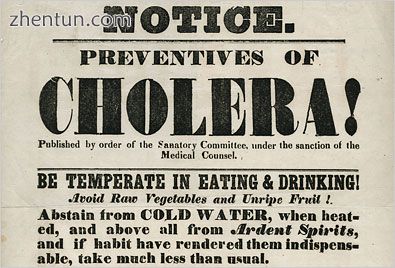
纽约市卫生局的手帐,1832年。过时的公共卫生建议表明,人们对该病及其真正的致病因素缺乏了解。
内容
1 大流行
1.1 首次,1817-1824年
1.2 第二次,1829年至1837年
1.3 第三次,1846-1860年
1.4 第四次,1863-1875年
1.5第五次,1881年-1896年
1.6第六次,1899–1923年
1.7第七次,1961–1975年
2 最近爆发
2.1 1990年
2.2 2000年
2.3 2010年
3 错误报告
4 参考
大流行病
第一次霍乱大流行发生在印度的孟加拉地区,从1817年到1824年在加尔各答附近。该病通过贸易路线从印度传播到东南亚,中东,欧洲和东非。[6]第二次大流行持续于1826年至1837年,由于运输和全球贸易的发展以及包括士兵在内的人类迁徙的增加,特别影响了北美和欧洲。[7]第三次大流行于1846年爆发,一直持续到1860年,扩展到北非,并到达南美,这是第一次特别影响到巴西。第四次大流行持续了1863年至1875年,从印度传播到那不勒斯和西班牙。第五次大流行是从1881年至1896年,开始于印度,并蔓延到欧洲,亚洲和南美。第六次大流行始于印度,始于1899年至1923年。由于对霍乱细菌有了更深入的了解,因此这些流行病的致命性降低。在这些流行病中,埃及,阿拉伯半岛,波斯,印度和菲律宾受到的打击最大,而其他地区,例如1892年的德国和1910-1911年的那不勒斯,也遭受了严重的暴发。第七大流行病始于1961年在印度尼西亚,其特征是出现了一种新的毒株,昵称为El Tor,该毒株在发展中国家仍持续存在(截至2019年[8])。[9]
1900年代初期,纽约市在20世纪的大部分时间里,霍乱在美洲没有发生。它在该世纪末重新出现在加勒比海地区,似乎很可能会持续下去。[10]
首次,1817-1824年
第一次霍乱大流行虽然受到了限制,但始于孟加拉国,然后在1820年蔓延到印度。在这场大流行中,数十万印度人和一万英国士兵死亡。[11]霍乱的爆发一直延伸到中国,印度尼西亚(仅爪哇岛就有十万多人死于该地区)和欧洲的里海,然后才逐渐消退。
第二次,1829年至1837年
1831年,第二次霍乱大流行蔓延到俄罗斯(见霍乱暴动),匈牙利(约10万人死亡)和德国。那年在埃及杀死了13万人。[12] 1832年,它到达伦敦和英国(有55,000多人死亡)[13]和巴黎。在伦敦,该病有6,536名受害者,并被称为“霍乱王国”。在巴黎,有20,000人死亡(人口65万),法国的总死亡人数为100,000。[14] 1833年,霍乱疫情使许多美洲印第安人部落(Pomo)丧生。该流行病于同年在魁北克,安大略,新斯科舍省[15]和纽约以及北美的太平洋沿岸地区蔓延。到1834年。在该国中部,其蔓延到与河流相连的城市。和汽船交通。[16]
同样,在华盛顿特区(那里没有可靠的死亡率数据),华盛顿海军船坞的一名被奴役劳工迈克尔·希纳(Michael Shiner)记录说:“霍乱在大约六月,七月和七月八月以及1832年9月爆发, [17]到1832年7月下旬,霍乱已蔓延至弗吉尼亚州,1832年8月7日,刘易斯·沃灵顿准将证实要在华盛顿市和他们的坟墓中每天进行12或13次葬礼。海军部长李维·伍德伯里(Levi Woodbury)霍乱在Gosport海军场上,“在那天[8月1日]中午至8月3日星期五早晨,在她的费尔菲尔德号航空母舰上的所有工作都停了下来,霍乱导致几人死亡发生,据报有十五或十六起暴力事件有所减少。” [18]
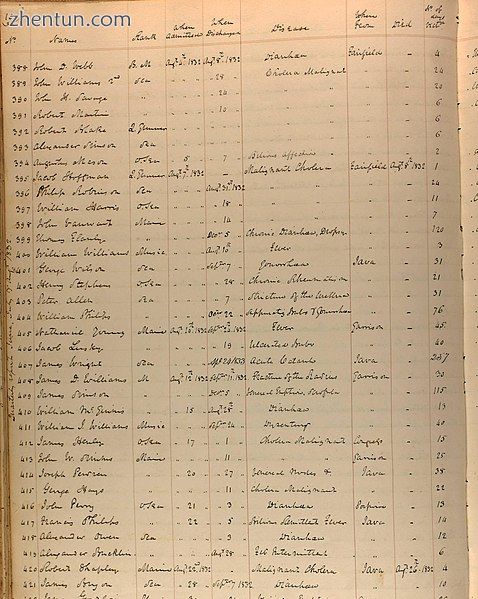
戈斯波特海军医院患者登记册1832年8月霍乱病例
引起霍乱的霍乱疫情已达到顶峰,引起未知和预后。 [19]霍乱在1833年和1850年影响了墨西哥的人口,促使官员隔离了某些人口并熏蒸了建筑物,尤其是在主要城市中心,但这种流行病是灾难性的。[20]
在这种大流行期间,科学界对霍乱病因的看法各不相同。在法国,医生认为霍乱与某些社区的贫困或环境恶劣有关。俄罗斯人认为这种疾病具有传染性,尽管医生不了解这种疾病的传播方式。美国认为霍乱是由新移民,特别是爱尔兰人带来的,流行病学家了解他们是从英国端口携带疾病。最后,一些英国人认为这种疾病可能源于神圣的干预。[6]
通过美国政府对控制该流行病的努力的支持,证明了政府在科学的发展和应用中具有直接作用的社会重要性。[21]
第三次,1846-1860年
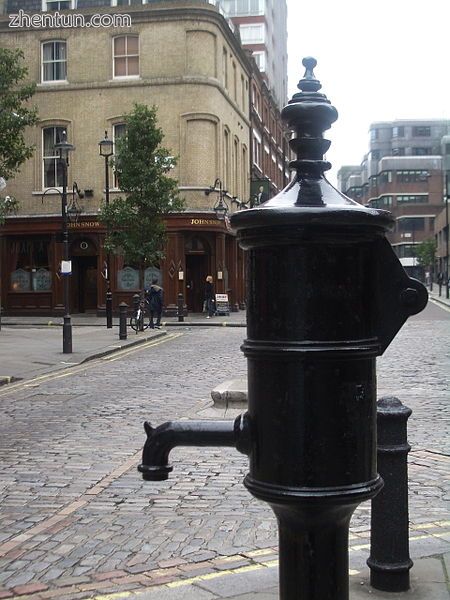
纪念约翰·斯诺的水泵,纪念他在1854年布罗德街霍乱爆发期间,研究污染水可能是霍乱的源头
第三次霍乱大流行严重影响了俄罗斯,造成超过100万人死亡。 1846年,麦加的霍乱死亡人数超过15,000。[22] 1848年,在英格兰和威尔士开始了为期两年的爆发,夺去了52,000人的生命。[23]
1849年,法国发生了第二次重大疫情。在伦敦,这是该城市历史上最严重的疫情,有14137人死亡,是1832年疫情的两倍多。霍乱在1849年袭击了爱尔兰,杀死了许多因饥荒和发烧而变得虚弱的爱尔兰饥荒幸存者。[24] 1849年,霍乱在英国主要端口城市利物浦,北美洲移民登船点和英格兰赫尔的1834人中有5308人死亡。[14]
北美爆发的疫情夺走了美国前总统詹姆斯·波克(James K.Polk)的性命。霍乱被认为是从英格兰的爱尔兰移民船上蔓延而来,遍及密西西比河水系,在圣路易斯[14]杀死了4,500多人,在新奥尔良[14]杀死了3,000多人。数千人死于纽约,这是爱尔兰移民的主要目的地。[14]霍乱在墨西哥夺走了200,000名受害者。[25]
那年,霍乱沿加利福尼亚,摩门教徒和俄勒冈小径传播,据信在1849-1855年的霍乱年代中,有6,000至12,000 [26]在前往加利福尼亚淘金热,犹他州和俄勒冈的途中死亡。[14]据信,在1832年至1849年的两次大流行期间,有15万美国人丧生。[27] [28]
1851年,一艘从古巴来的船将疾病传播到大加那利岛。[29]据认为,在夏季,该岛有58,000人口中有6,000多人死亡[30]。
1852年,霍乱向东传播到印度尼西亚,然后在1854年被带到印度尼西亚和日本。菲律宾在1858年被感染,1859年在韩国被感染。1859年,孟加拉爆发,旅客和部队将这种疾病传播给伊朗。 ,伊拉克,阿拉伯和俄罗斯。[22]在1858年至1902年间,日本至少爆发了7次霍乱大爆发。1858-60年,东京爆发了10万至20万人死于霍乱的事件。[31]
1854年,芝加哥爆发的霍乱夺去了5.5%的人口(约3500人)的生命。[14] [32] 1853–54年,伦敦的流行病夺走了10,739条生命。 1854年,在医生约翰·斯诺(John Snow)将附近的百老街水泵污染后,并说服官员卸下了手柄,伦敦的布罗德大街霍乱疫情就此终结。[33]他的研究证明受污染的水是传播霍乱的主要因素,尽管他没有发现污染物。要使该信息被相信并完全付诸行动,将需要很多年。[34]在1854–55年的疫情中,西班牙有236,000多人死于霍乱。[35]该病于1854年和1855年到达南美,委内瑞拉和巴西是受害者。[25]在第三次大流行中,突尼斯没有受到前两次大流行的影响,认为欧洲人带来了这种疾病。他们指责他们的卫生习惯。一些美国科学家开始相信,霍乱与非裔美国人有某种联系,因为该病在南部的黑人人口中很普遍。目前的研究人员指出,他们的人口在卫生基础设施和医疗保健方面得不到足够的服务,他们生活在水路附近,旅客和血管通过水路运送疾病。[36]
从1855年11月10日到1856年12月,该病在波多黎各蔓延,造成25,820名受害者。[37]扩大了墓地,以埋葬霍乱的受害者。[38]
第四次,1863-1875年
本世纪第四次霍乱大流行始于孟加拉地区的恒河三角洲,并与穆斯林朝圣者一起前往麦加。在第一年,该流行病夺走了90,000名麦加朝圣者中的30,000名。[39]霍乱传播到整个中东,并被带到俄罗斯,欧洲,非洲和北美,在每种情况下都是从端口城市和内陆水道传播的。
大流行在1865年到达北非,并蔓延到撒哈拉以南非洲,在1869-70年间在桑给巴尔造成70,000人死亡。[40] 1866年,霍乱在俄罗斯夺走了90,000人的生命。[41]据估计,随着奥普战争(1866年)而传播的霍乱这一流行病在奥地利帝国夺去了165,000人的生命,其中匈牙利和比利时各夺走了30,000人,荷兰夺走了20,000人。[42]
1866年6月在伦敦,东区的局部流行病夺去了5596人的生命,正当伦敦市正在完成其主要污水和水处理系统的建设时(参见伦敦污水处理系统);东端部分还不太完整。[43]流行病学家威廉·法尔(William Farr)将东伦敦自来水公司确定为污染源。 Farr利用John Snow和其他人的先前工作指出饮用水污染是1854年爆发霍乱的可能原因。迅速采取行动避免了进一步的死亡。[14]同年,在当地自来水厂使用受污染的管水在南威尔士州的伊斯塔利费拉造成了一次小规模爆发。与公司有关的工人及其家人受到的影响最大,有119人死亡。
1867年,在阿尔及利亚,意大利因该病丧生了113,000人,其中80,000人丧生。[40]随着霍乱从新奥尔良蔓延到密西西比河及其支流的其他端口,1870年代北美爆发的疫情杀死了约50,000名美国人。没有一个城市有适当的卫生系统,霍乱通过供水和接触传播。[27] [44]
第五次,1881年-1896年
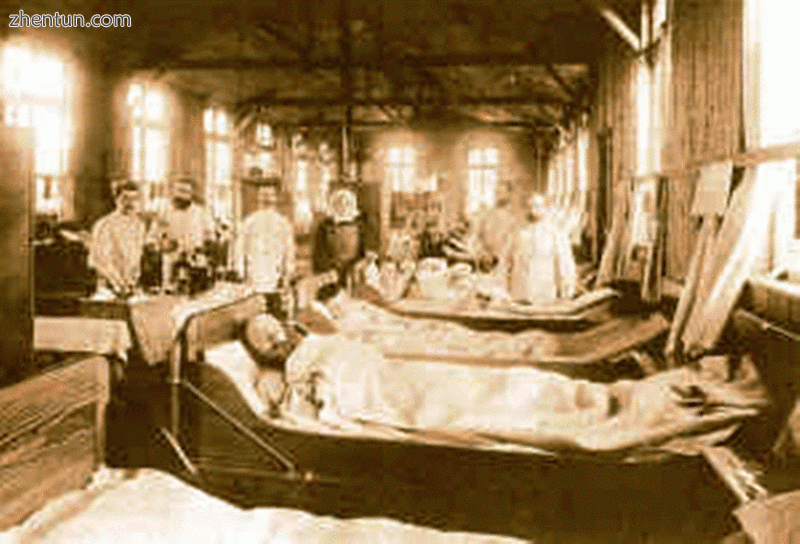
1892年在汉堡医院病房爆发霍乱
根据A. J. Wall的说法,第五次霍乱大流行是该流行病的1883年至1887年,在欧洲造成25万人死亡,而在美洲则造成至少50,000人死亡。霍乱夺走了俄罗斯(1892)的267,890人的生活; [45]西班牙的120,000人; [46]日本的90,000人和波斯的60,000多人。[45]在埃及,霍乱夺走了58,000多人的生命。 1892年在汉堡的爆发造成8600人死亡。尽管通常由市政府对这种流行病的毒力负责,但基本上没有改变。这是欧洲最近一次严重的霍乱爆发,因为城市改善了卫生条件和供水系统。
第六次,1899–1923年
由于公共卫生的进步,第六次霍乱大流行在西欧影响不大,但是霍乱死亡使俄罗斯主要城市和奥斯曼帝国遭受的打击尤其严重。 1900年至1925年,俄罗斯有超过500,000人死于霍乱,这也是由于革命和战争而导致社会混乱的时期。[47]
1902年至1904年的霍乱流行在菲律宾夺走了200,000人的生命,[48]其中包括革命英雄和第一任总理Apolinario Mabini。从19世纪到1930年,麦加朝圣期间霍乱爆发了27次。[47]第六次大流行在印度造成80万人丧生。
在美国的最后一次爆发是在1910-1911年间,当时的轮船Moltke将感染者从那不勒斯带到了纽约市。警惕的卫生当局在斯温本岛上隔离了感染者。 11人死亡,包括岛上医院的一名医护人员。[49] [50] [51]
在这段时间里,由于移民和旅行者经常从受感染的地方携带霍乱,因此该疾病与每个社会的局外人都有联系。意大利人指责犹太人和吉普赛人,印度人指责印度人是“肮脏的原住民”,而美国人则认为这种疾病来自菲律宾。[52]
第七次,1961–1975年
第七次霍乱大流行始于印度尼西亚,在受到拉伤后被称为El Tor [53],并于1963年到达东巴基斯坦(现为孟加拉国),1964年到达印度和1966年进入苏联。1973年从北非传播到意大利。 1970年代后期,日本和南太平洋地区爆发了小规模疫情。 1970年7月在敖德萨爆发,1972年巴库附近爆发霍乱疫情的报道也很多,但在苏联被制止了。[需要引文] 1970年,霍乱爆发袭击了伊斯坦布尔的Sağmalcılar地区,然后是贫民窟,夺走了50多条生命;最终,事件的恶名导致该地区更名为Bayrampa**a。同样在1970年,8月在耶路撒冷报道了几起案件。
最近爆****发
1990年代
1991年1月至1994年9月:南美爆发疫情,有人称是一艘中国血管排放压舱水而引发的。从秘鲁开始,[54]有104万例确诊病例,近10,000人死亡。病原体是O1 El Tor毒株,与第七次大流行毒株的差异很小。 1992年,亚洲出现了一种新菌株,一种非O1不可凝集的弧菌(NAG),名为O139 Bengal。它首先在印度的泰米尔纳德邦发现,并在南亚流离失所的El Tor住了一段时间。从1995年开始,患病率下降到所有病例的10%左右。它被认为是El Tor和经典毒株之间的中间产物,并出现在新的血清群中。科学家警告霍乱细菌对甲氧苄啶,磺胺甲恶唑和链霉素等药物具有广谱耐药性。
1994年7月在刚果民主共和国戈马爆发,到8月中旬夺去了12,000人的生命。在最坏的时期,据估计每天有多达3000人死于霍乱。[55]
在美国路易斯安那州和得克萨斯州的咸淡水域中,发现了墨西哥湾沿岸霍乱的持久毒株,导致从这些地区向该国其他地区运送海鲜可能导致的情况。建议医务人员在评估未出行者的症状时要考虑霍乱。由于良好的卫生和预警系统,南部地区曾发生过几次疫情,但没有重大疫情爆发。据指出,在拉丁美洲流行的El Tor毒株两年中的病例要比在墨西哥湾沿岸毒株中20年的病例要多。[56]
2000年代
2000年,世界卫生组织正式报告了约140,000例霍乱病例。非洲国家占这些案件的87%。[57]
2007年7月至12月:伊拉克缺乏清洁的饮用水导致霍乱暴发。[58] [59]截至2007年12月2日,联合国已报告22例死亡和4,569例实验室确认病例。[60]
2007年8月:霍乱在印度奥里萨邦开始流行。疫情影响了Rayagada,Koraput和Kalahandi地区,该地区有2,000多人入院。[61]
2008年3月至4月:来自越南20个省的2490人因急性腹泻而住院。在这些住院患者中,有377例霍乱测试呈阳性。[62]
2008年8月至10月:截至2008年10月29日,伊拉克已核实了644例实验室确认的霍乱病例,包括8例死亡。[63]
2008年11月:无国界医生报告说,在刚果民主共和国东部省会戈马的一个难民营中爆发了霍乱。[64]据报道,在11月7日至9日之间,约有45例病例得到了治疗。
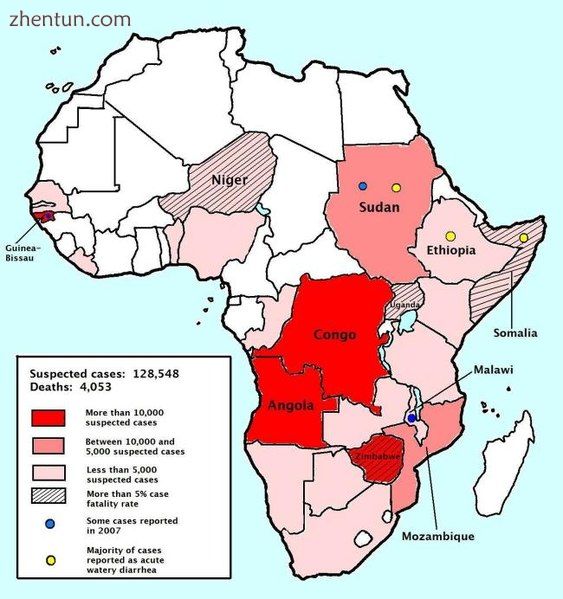
截至2009年2月12日,撒哈拉以南非洲的霍乱感染病例数达到128,548,死亡人数为4,053。
2009年1月:南非的姆普马兰加省确认了381例新的霍乱病例,自2008年11月以来治疗的病例总数达到2276例。爆发以来,该省有19人死亡。[65]
2008年8月至2009年4月:在持续到2009年的2008年津巴布韦霍乱暴发中,该国估计有96,591人感染霍乱,到2009年4月16日,据报死亡4,201人。[66] [67]根据世界卫生组织的统计,在2009年3月22日至28日的一周中,“粗病例死亡率”从4.2%降至3.7%。[66]从2009年3月29日至2009年4月7日的每日更新中,列出了1748例病例和64例死亡,每周病死率为3.66%(见上表)。[68] 4月8日至4月16日期间的病例列出1375例新病例和62例死亡(导致的病死率为4.5%)。[69] 2009年1月和2月初的大部分时间,病死率一直保持在4.7%以上。[70]
2010年代
2010年8月:在36个州中的12个州得到广泛证实的疾病爆发后,尼日利亚的霍乱疫情已达到流行病的程度。报告了6400例,其中352例死亡。卫生部将这次暴发归咎于季节性降雨过多和卫生条件差。[71]
2010年10月–目前,海地和多米尼加共和国:2010年10月下旬,海地爆发了疫情。[72]截至11月16日,海地卫生部报告死亡人数为1,034,霍乱症状住院总数超过16,700。[73]疫情归咎于尼泊尔联合国维持和平人员营地。这是有争议的,然后被联合国承认。[74]暴发始于阿蒂博尼特河上游; [75]人们首先从这条河中取水感染了该病。[76]此外,一些科学家认为海地的飓风和天气情况加剧了疫情的后果,卫生设施受损使疫情得以传播。[75]到2010年11月,该病已蔓延到邻国多米尼加共和国。截至2016年8月,该流行病在海地已正式使至少790,000人患病,并杀死了9,000多人,[77]但实际负担可能要高得多。[78]在邻国多米尼加共和国,至少有32,000例可疑病例和500例相关死亡。[79]在海地,马修飓风使疫情进一步恶化,马修飓风在2016年秋季袭击了海地南部。[80]联合国承认其在这一流行病中的作用。[81] 2016年8月,联合国承诺通过4亿美元的基金与该疾病作斗争并向受害者提供援助; [82]但是,截至2017年4月,成员国在认捐的4亿美元中仅捐献了1000万美元。[82]
2011年1月,约411名委内瑞拉公民参加了在多米尼加共和国举行的婚礼,他们在庆祝活动中吃了酸橘汁腌鱼(用柠檬汁烹制的生鱼)。当他们返回加拉加斯和委内瑞拉其他城市时,其中一些旅行者患有霍乱症状。到1月28日,委内瑞拉卫生当局已确认了近111例病例,该机构迅速设置了800个电话号码,供想知道自己是否被感染的人致电。在国际上,哥伦比亚确保了其东部边界免受移民和可能的疾病传播。多米尼加官员开始了一项全国性研究,以确定爆发原因,并警告居民与食用生鱼和贝类有关的迫在眉睫的危险。截至2011年1月29日,委内瑞拉没有一例死亡,但有两名患者住院。由于受害者迅速寻求帮助,因此发现并控制了疫情。[83]
2011年:尼日利亚和刚果民主共和国爆发疫情;后者遭受了多年的战争破坏。索马里遭受了霍乱和饥荒的双重打击,与难民营,有限的卫生设施和严重的干旱有关,导致饥荒和抵抗力下降。[84]
2011年和2012年,除北非以外的所有非洲地区的多个非洲国家都爆发了霍乱疫情;在受影响的国家中,加纳领导了一场激烈的洗手运动。[85] 2012年,塞拉利昂报告了约21,500例病例,其中290人死亡。[86]
2013年8月21日,美国国务院发布了一条安全信息,警告在古巴或前往古巴旅行的美国公民关于哈瓦那爆发霍乱的消息。它可能与据报道在古巴东部爆发的霍乱有关。[87]
2014年加纳一场持续的霍乱疫情给首都阿克拉造成沉重打击,到9月,约100人丧生,超过11,000例病例。由于受到附近国家埃博拉病毒消息的影响,它没有引起多少注意。 2011年和2012年,加纳的霍乱疫情加在一起,总计16,000例病例和130例死亡。[88]
2015年9月:坦桑尼亚持续的霍乱流行导致13例死亡,迄今已有近1000例病例-主要在O1 Ogawa毒株引起的达累斯萨拉姆以及莫罗戈罗和伊林加[89]。在坦Bur尼喀湖地区爆发了较早的疫情,始于从布隆迪逃离的难民。 2015年5月报告了30人死亡和4400例。[90]
2017年,索马里:2017年1月在索马里爆发了持续性暴发。截至5月底,共有50,000多例病例,与880例死亡相关;病死率为1.7%(儿童为2.1%)。该国的18个地区中有16个参与其中,受影响最大的是Bay和Togdheer。[91]
在2017年4月,也门再次爆发(该疫情于2016年10月开始)。[92] [93] 联合国儿童基金会和世界卫生组织(世卫组织)估计,到2017年6月24日,该国的病例总数超过20万,死亡1300。儿童基金会和卫生组织将这次暴发归因于该国正在进行的内战,营养不良,卫生设施中断和获得清洁水的中断。[92] [94]也门保健服务的崩溃加剧了疫情的影响;许多卫生工作者几个月都没有得到报酬。[92]爆发是在也门首都萨那的污水处理系统于4月17日停止运作十天后发生的。[92]大约一半的病例和四分之一的死亡是儿童。 8月14日,世卫组织表示,也门约有500,000 [95]人受到霍乱的影响。[93]世卫组织称其为“世界上最严重的霍乱暴发”。[96]
2018年8月,阿尔及利亚卫生部宣布在首都阿尔及尔及其周边地区的Tipaza,Blida,Bouira,Medea和Ain Defla确诊56例霍乱病例,据报道有2例霍乱病例死亡流行[97]。蒂帕萨Hamr El-Ain镇的水源被发现是霍乱污染的根源。禁止使用水源。[98]
2018年9月6日,津巴布韦宣布爆发霍乱,政府于2018年9月11日宣布进入紧急状态,迄今已造成48人死亡,至少98人确诊。 [99] [100]
虚假报告
主要文章:芝加哥1885年霍乱流行神话
一个持续存在的城市神话指出,1885年,在芝加哥有9万人死于霍乱和伤寒,但这个故事没有事实依据。[101] 1885年,一场暴雨将芝加哥河及其伴随的污染物冲入了密歇根湖,足以使该市的供水受到污染。但是,由于霍乱在该市不存在,因此没有与霍乱有关的死亡。由于污染,该市进行了更改,以改善对污水的处理并避免发生类似事件。
参考文献
"Cholera's seven pandemics Archived 2016-03-02 at the Wayback Machine". CBC News. October 22, 2010.
"Crisis in Yemen Archived March 9, 2019, at the Wayback Machine"
Tatem, A.J.; Rogers, D.J.; Hay, S.I. (2006). "Global Transport Networks and Infectious Disease Spread". Adv Parasitol. Advances in Parasitology. National Institutes of Health. 62: 293–343. doi:10.1016/S0065-308X(05)62009-X. ISBN 9780120317622. PMC 3145127. PMID 16647974.
Handa, Sanjeev (February 16, 2016). "Cholera: 背景". MedScape. Retrieved April 23, 2016.
Beardsley GW (2000). "The 1832 Cholera Epidemic in New York State: 19th Century Responses to Cholerae Vibrio (part 1)". The Early America Review. 3 (2). Archived from the original on 2010-05-02. Retrieved 2010-02-01.
Hayes, J.N. (2005). Epidemics and Pandemics: Their Impacts on Human History. Santa Barbara, CA: ABC-CLIO. pp. 214–219.
McNeil J. Something New Under The Sun: An Environmental History of the Twentieth Century World (The Global Century Series).
"Cholera – Vibrio cholerae infection | Cholera | CDC". www.cdc.gov. 2017-05-16. Archived from the original on 2015-03-17. Retrieved 2018-04-04.
Aberth, John (2011). Plagues in World History. Lanham, MD: Rowman & Littlefield. p. 102. ISBN 978-0-7425-5705-5.
Blake, PA (1993). "Epidemiology of cholera in the Americas". Gastroenterology Clinics of North America. 22 (3): 639–60. PMID 7691740.
Pike J (2007-10-23). "Cholera- Biological Weapons". Weapons of Mass Destruction (WMD). GlobalSecurity. Archived from the original on 2010-03-23. Retrieved 2010-02-01.
Cholera Epidemic in Egypt (1947) Archived 2010-11-22 at the Wayback Machine.
"Asiatic Cholera Pandemic of 1817". Archived from the original on 2014-12-28. Retrieved 2015-01-04.
Charles E. Rosenberg (1987). The cholera years: the United States in 1832, 1849 and 1866. Chicago: University of Chicago Press. ISBN 978-0-226-72677-9.
"Browsing Vol. 14 (1935) by Subject "Epidemic of cholera in Halifax, Nova Scotia....1834 [Title],"". dalspace.library.dal.ca. Archived from the original on 2015-06-19. Retrieved 2015-06-19.
Wilford JN. "How Epidemics Helped Shape the Modern Metropolis". Archived from the original on 2017-03-14. Retrieved 2017-02-06. On a Sunday in July 1832, a fearful and somber crowd of New Yorker's gathered in City Hall Park for more bad news.
Diary of Michael Shiner Relating to the History of the Washington Navy Yard 1813–1869 https://www.history.navy.mil/res ... r/introduction.html Archived 2019-03-27 at the Wayback Machine Naval History and Heritage Command 2015, 49 editor John G. Sharp Retrieved 7 March 2019
Sharp, John G. Cholera at Gosport Navy Yard 1832 http://www.usgwarchives.net/va/portsmouth/shipyard/nnysharp5.html Archived 2019-03-08 at the Wayback Machine accessed 7 March 2019
New York Times. 2008-04-15. Missing or empty |title= (help)
Gabriela Soto Laveaga and Claudia Agostoni, "Science and Public Health in the Century of Revolution" in A Companion to Mexican History and Culture, ed. William H. Beezley. Blackwell Publishing Ltd. 2011, p. 562.
Audretsch; et al. (2002). "The Economics of Science and Technology". The Journal of Technology Transfer. 27 (2): 159. doi:10.1023/A:1014382532639.
Asiatic Cholera Pandemic of 1846–63 Archived 2010-12-28 at the Wayback Machine. UCLA School of Public Health.
Cholera's seven pandemics Archived 2008-05-13 at the Wayback Machine, cbc.ca, December 2, 2008.
"The Irish Famine". Archived from the original on October 27, 2009. Retrieved 2014-06-09.
Byrne, Joseph Patrick (2008). Encyclopedia of Pestilence, Pandemics, and Plagues: A-M. ABC-CLIO. p. 101. ISBN 978-0-313-34102-1. Archived from the original on 2013-05-09. Retrieved 2016-07-28.
Unruh, John David (1993). The plains across: the overland emigrants and the trans-Mississippi West, 1840–60. Urbana, IL: University of Illinois Press. pp. 408–10. ISBN 978-0-252-06360-2.
Beardsley GW (2000). "The 1832 Cholera Epidemic in New York State: 19th Century Responses to Cholerae Vibrio (part 2)". The Early America Review. 3 (2). Archived from the original on 2010-05-04. Retrieved 2010-02-01. (New citation needed—citation (#15) "The 1832 Cholera Epidemic – Part 2" does not mention the 1870s outbreak briefly mentioned here).
Vibrio cholerae in recreational beach waters and tributaries of Southern California.
HISTORICAL GEOGRAPHICAL APPROACH IN THE BEHAVIOR OF THE EPIDEMIC OF THE CHOLERA MORBUS OF 1851 IN THE PALMS OF GREAT CANARY Archived 2017-10-22 at the Wayback Machine p.626
Historia de la medicina en Gran Canaria Archived 2017-10-22 at the Wayback Machine p.545-546
Kaoru Sugihara, Peter Robb, Haruka Yanagisawa, Local Agrarian Societies in Colonial India: Japanese Perspectives, (1996), p. 313.
Chicago Daily Tribune Archived 2009-08-31 at the Wayback Machine, 12 July 1854
Snow, John (1855). On the Mode of Communication of Cholera. Archived from the original on 2012-03-06. Retrieved 2010-12-19.
Frerichs, Ralph R. "John Snow and the removal of the Broad Street pump handle". www.ph.ucla.edu. Archived from the original on 2018-06-28. Retrieved 2018-07-13. In 1866, twelve years after the event, Dr. Edwin Lankester wrote: 'The Board of Guardians met to consult as to what ought to be done. Of that meeting, the late Dr. Snow demanded an audience. He was admitted and gave it as his op枕外隆凸尖 that the pump in Broad Street, and that pump alone, was the cause of all the pestilence. He was not believed – not a member of his own profession, not an individual in the parish believed that Snow was right. But the pump was closed nevertheless and the plague was stayed.'
Kohn, George C. (2008). Encyclopedia of Plague and Pestilence: from Ancient Times to the Present. Infobase Publishing. p. 369. ISBN 978-0-8160-6935-4. Archived from the original on 2016-06-10. Retrieved 2016-07-28.
Hayes, J. N. (2005). Epidemics and Pandemics: Their Impacts on Human History. Santa Barbara, CA: ABC-CLIO. p. 233.
"EPIDEMIA Y SOCIEDAD: EFECTOS DEL CóLERA MORBO EN PUERTO RICO Y EN COSTA RICA A MEDIADOS DEL SIGLO XIX". University of Costa Rica (in Spanish). Retrieved 10 June 2019.
Mari Mut, José A. "Cementerios Antiguos de Puerto Rico- San Sebastián". edicionesdigitales (in Spanish). Archived from the original on 2018-09-27. Retrieved 2019-06-10.
"Cholera's seven pandemics". CBC News. CBC-Radio Canada. May 9, 2008. Archived from the original on 2 March 2016. Retrieved 23 February 2016.
Byrne, Joseph Patrick (2008). Encyclopedia of Pestilence, Pandemics, and Plagues: A-M. ABC-CLIO. p. 107. ISBN 978-0-313-34102-1. Archived from the original on 2013-11-26. Retrieved 2016-07-28.
Eastern European Plagues and Epidemics 1300–1918 Archived 2011-06-05 at the Wayback Machine.
Smallman-Raynor, Matthew R.; Cliff, Andrew D. (June 2004). "Impact of infectious diseases on war". Infectious Disease Clinics of North America. 18 (2): 341–368. doi:10.1016/j.idc.2004.01.009. PMID 15145384.
Johnson, Steven (2006). The ghost map : the story of London's most terrifying epidemic—and how it changed science, cities, and the modern world. New York: Riverhead Books. ISBN 978-1594489259.
The Cholera Epidemic of 1873 in the United States. (The Introduction of Epidemic Cholera Through the Agency of the Mercantile Marine ... By John M. Woodworth. Reports Prepared Under the Direction of the Surgeon-General of the Army:-A. History of the Cholera Epidemic of 1873 by Ely McClellan. B. History of the Travels of Asiatic Cholera. By John C. Peters and Ely McClellan. C. Bibliography of Cholera. By John S. Billings.). 1875. pp. 704–.
Cholera. Encyclop**dia Britannica (11th ed.). New York : Encyclopaedia Britannica. 1911. p. 265. Archived from the original on 2016-10-26. Retrieved 2010-01-31.
"The cholera in Spain". New York Times. 1890-06-20. Archived from the original on 2018-07-10. Retrieved 2008-12-08.
"Cholera (pathology): Seven pandemics". Britannica Online Encyclopedia. Archived from the original on 2009-06-27. Retrieved 2014-06-29.
1900s: The Epidemic years Archived April 20, 2005, at the Wayback Machine, Society of Philippine Health History.
"Cholera Kills Boy. All Other Suspected Cases Now in Quarantine and Show No Alarming Symptoms" (PDF). New York Times. July 18, 1911. Retrieved 2008-07-28. The sixth death from cholera since the arrival in this port from Naples of the steamship Moltke, thirteen days ago, occurred yesterday at Swineburne Island. The victim was Francesco Farando, 14 years old.
"More Cholera in Port". Washington Post. October 10, 1910. Archived from the original on December 16, 2008. Retrieved 2008-12-11. A case of cholera developed today in the steerage of the Hamburg-American liner Moltke, which has been detained at quarantine as a possible cholera carrier since Monday last. Dr. A.H. Doty, health officer of the port, reported the case tonight with the additional information that another cholera patient from the Moltke is under treatment at Swinburne Island.
The Boston Medical and Surgical journal. Massachusetts Medical Society. 1911. In New York, up to July 22, there were eleven deaths from cholera, one of the victims being an employee at the hospital on Swinburne Island, who had been discharged. The tenth was a lad, seventeen years of age, who had been a steerage passenger on the steamship, Moltke. The plan has been adopted of taking cultures from the intestinal tracts of all persons held under observation at Quarantine, and in this way it was discovered that five of the 500 passengers of the Moltke and Perugia, although in excellent health at the time, were harboring cholera microbes.
Hayes, J.N. (2005). Epidemics and Pandemics: Their Impacts on Human History. Santa Barbara CA: ABC-CLIO. p. 349.
Sack DA, Sack RB, Nair GB, Siddique AK (January 2004). "Cholera". Lancet. 363 (9404): 223–33. doi:10.1016/S0140-6736(03)15328-7. PMID 14738797.
Nathaniel C. Nash (10 March 1992). "Latin Nations Feud Over Cholera Outbreak". The New York Times. Archived from the original on 31 August 2012. Retrieved 2011-02-16.
Echenberg, Myron (2011-02-28). Africa in the Time of Cholera. ISBN 9781139498968. Archived from the original on 2014-06-28. Retrieved 2015-01-04.
P.A. Blake (September 1993). "Epidemiology of cholera in the Americas". Gastroenterol Clin North Am. 22(3). 22: 639–60. PMID 7691740.
Disease fact sheet: Cholera Archived 2011-07-16 at the Wayback Machine. IRC International Water and Sanitation Centre.
James Glanz; Denise Grady (12 September 2007). "Cholera Epidemic Infects 7,000 People in Iraq". The New York Times. Archived from the original on 11 November 2017. Retrieved 2011-02-26.
"U.N. reports cholera outbreak in northern Iraq". CNN. 2007-08-30. Archived from the original on 2010-06-04. Retrieved 2010-02-01.
Smith D. (2007-12-02). "Cholera crisis hits Baghdad". The Observer. London. Archived from the original on 2013-09-01. Retrieved 2010-02-01.
Jena S (2007-08-29). "Cholera death toll in India rises". BBC News. Archived from the original on 2009-09-30. Retrieved 2010-02-01.
Cholera Country Profile: Vietnam Archived 2017-11-14 at the Wayback Machine. WHO.
"Situation report on diarrhoea and cholera in Iraq". ReliefWeb. 2008-10-29. Archived from the original on 2008-11-11. Retrieved 2010-02-01.
Sky News Doctors Fighting Cholera In Congo.
381 new cholera cases in Mpumalanga Archived 2009-02-27 at the Wayback Machine, News24, 24 January 2009.
World Health Organization. Cholera in Zimbabwe: Epidemiological Bulletin Number 16 Week 13 (22–28 March 2009) Archived 26 March 2012 at the Wayback Machine. March 31, 2009.; WHO Zimbabwe Daily Cholera Update, 16 April 2009 Archived 26 March 2012 at the Wayback Machine.
"Zimbabwe: Cholera Outbreak Kills 294". The New York Times. Associated Press. 22 November 2008. Archived from the original on 29 July 2018. Retrieved 2011-02-26.
World Health Organization: Zimbabwe Daily Cholera Updates Archived 2012-03-26 at the Wayback Machine.
WHO Zimbabwe Daily Cholera Update, 16 April 2009 Archived 26 March 2012 at the Wayback Machine.
Mintz & Guerrant 2009
Cholera epidemic death toll rises to 352 Archived 2010-12-05 at the Wayback Machine, MSNBC, 25 August 2010.
"Haiti's Latest Misery". The New York Times. 26 October 2010. Archived from the original on 26 February 2013. Retrieved 2011-02-26.
"Official: Cholera death toll in Haiti has passed 1,000". NBC News. Associated Press. 16 November 2010. Retrieved 2011-02-26.
Katz, Jonathan M. (17 August 2016). "U.N. Admits Role in Cholera Epidemic in Haiti". The New York Times. Archived from the original on 8 June 2017. Retrieved 25 June 2017.
Aubrey Ann Parker, "Cholera in Haiti: the Climate Connection" Archived 2010-11-17 at the Wayback Machine, Circle of Blue, 2010
"WHO, "Final Report of the Independent Panel of Experts on the Cholera Outbreak in Haiti"" (PDF). un.org. Archived (PDF) from the original on 2012-09-15. Retrieved 2015-06-19.
"Ministère de la Santé Publique et de la Population (MSPP): Rapport de Cas" (PDF) (病例报告). MSPP. 20 August 2016. Archived (PDF) from the original on 4 November 2016. Retrieved 27 September 2016.
Luquero, Francisco J.; Rondy, Marc; Boncy, Jacques; Munger, André; Mekaoui, Helmi; Rymshaw, Ellen; Page, Anne-Laure; Toure, Brahima; Degail, Marie Amelie; Nicolas, Sarala; Grandesso, Francesco; Ginsbourger, Maud; Polonsky, Jonathan; Alberti, Kathryn P.; Terzian, Mego; Olson, David; Porten, Klaudia; Ciglenecki, Iza (2016). "Mortality Rates during Cholera Epidemic, Haiti, 2010–2011". Emerging Infectious Diseases. 22 (3): 410–416. doi:10.3201/eid2203.141970. PMC 4766911. PMID 26886511.
Canada, Government of Canada, Global Affairs. "Cholera in Dominican Republic and Haiti". Travel.gc.ca. Archived from the original on 12 June 2017. Retrieved 25 June 2017.
Ahmed, Azam (2016-10-14). "Cholera Deepens Haiti's Misery After Hurricane". The New York Times. ISSN 0362-4331. Archived from the original on 2017-06-30. Retrieved 2017-06-08.
Sengupta, Somini (2016-12-01). "U.N. Apologizes for Role in Haiti's 2010 Cholera Outbreak". The New York Times. ISSN 0362-4331. Archived from the original on 2018-02-02. Retrieved 2017-06-08.
Section, United Nations News Service (2016-11-30). "UN News – Haiti: UN's new approach on cholera puts people at heart of the response". UN News Service Section. Archived from the original on 2017-10-10. Retrieved 2017-06-08.
[1][permanent dead link], WRAL
Jeffrey Gettleman / New York Times News Service, "U.N.: Cholera scourge now ravaging Somalia" Archived 2011-10-19 at the Wayback Machine, Bend Bulletin, 13 August 2011
Odoi-Larbi, Stephen (8 October 2012). "Ghana: Attitudinal Change Is the Key to Eradicating Cholera – Bagbin". Retrieved 25 June 2017 – via AllAfrica.
Reports, Vaccine News. "Cholera outbreak in Sierra Leone slows". Archived from the original on 4 October 2013. Retrieved 25 June 2017.
"State Department Warns U.S. Citizens of Cholera Outbreak in Havana, Cuba". The Weekly Standard. Archived from the original on 2013-08-21. Retrieved 2013-08-21.
"Cholera Death Toll Rises To 100". Archived from the original on 2014-09-12. Retrieved 2015-01-04.
"Cholera – United Republic of Tanzania". WHO. Archived from the original on 2015-09-13. Retrieved 2015-09-12.
"Tanzania cholera epidemic improving". UN. Archived from the original on 2015-08-14. Retrieved 2015-09-12.
"Cholera situation in Somalia" (PDF). WHO. May 2017. Archived (PDF) from the original on 14 November 2017. Retrieved 27 June 2017.
Johannes Bruwer (25 June 2017). "The horrors of Yemen's spiralling cholera crisis". BBC News. BBC. Archived from the original on 25 June 2017. Retrieved 25 June 2017.
"UN: 1,310 dead in Yemen cholera epidemic". Al Jazeera. 25 June 2017. Archived from the original on 25 June 2017. Retrieved 25 June 2017.
"Statement from UNICEF Executive Director Anthony Lake and WHO Director-General Margaret Chan on the cholera outbreak in Yemen as suspected cases exceed 200,000". UNICEF. 24 June 2017. Archived from the original on 2 July 2017. Retrieved 25 June 2017.
"Cholera count reaches 500 000 in Yemen". World Health Organization. Archived from the original on 2017-08-17. Retrieved 2017-08-17.
Dwyer, Colin. "Yemen Now Faces 'The Worst Cholera Outbreak In The World,' U.N. Says". National Public Radio. Archived from the original on 24 June 2017. Retrieved 25 June 2017.
"Situation Epidemiologique des Cas de Cholera" (PDF). Algeria Ministry of Health, Population, and Hospital Reform (in French). Archived from the original (PDF) on 30 August 2018. Retrieved 29 August 2018.
"Health Alert: U.S. Embassy Algiers, Algeria". US Embassy in Algiers. 2018-08-26. Archived from the original on 30 August 2018. Retrieved 29 August 2018.
"Zimbabwe: Cholera outbreak snapshot (as of 27 September 2018)". reliefweb.int. Archived from the original on 28 September 2018. Retrieved 2018-09-27.
"Cholera crisis signals deeper problems for Zimbabwe". www.aljazeera. Archived from the original on 2018-09-27. Retrieved 2018-09-27.
"Did 90,000 people die of typhoid fever and cholera in Chicago in 1885?". The Straight Dope. 2004-11-12. Archived from the original on 2008-10-06. Retrieved 2010-02-01. |